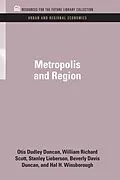This is Volume II of a series of six on Urban and Regional Economics originally published in 1960. This study discusses the future of urban developments in America. Has they already have megapolitan belts, sprawling regions of quasi-urban settlement stretching along coast lines or major transportation routes, current concepts of the community stand to be challenged. What will remain of local government and institutions if locality ceases to have any historically recognizable form? The situations described in this book pertain to the mid-century United States of some 150 million people. What serviceable image of metropolis and region can we fashion for a country of 300 million? The prospect for such a population size by the end of the twentieth century is implicit in current growth rates, as is the channeling of much of the growth into areas now called metropolitan or in process of transfer to that class.
Autorentext
Otis Dudley Duncan, William Richard Scott, Stanley Lieberson, Beverly Davis Duncan, and Hal H. Winsborough
Zusammenfassung
This book explains why the earliest cities had grid-form street systems, what conditions led to their being overwhelmingly preferred for 5000 years throughout the world, why the Founding Fathers wanted gridform cities and how they affect economic transactions. Real property has been instrumental in forming urban settlements for 5000 years, but virtually all urban form commentary, theory and research has ignored this reality. The result is an incomplete and flawed understanding of cities. Real property became a means of arranging spatial patterns caused by millennia of human evolutionary and historical developments with respect to access and movement. As a result, access to resources of all types became a regulatory mechanism controlled, at least in part, by real property ownership.The effects of real property on urban spatial patterns are currently best seen by examining American urban space, which has changed significantly over the past 200 years. This change, which began in the 1840s and established path dependence through a combination of design thought, sentimental pastoralism and financial prowess resulted in an urban regime shift that diminished economic resilience. This book offers a rethinking of how real property relates to real space, examines the thought of form promoters, links space, property, neurological evolution and settlement form, shows access is measurable and describes the plusses and minuses of functionalism, rent seeking, general purpose technology, grid-form street systems and what the American Founding Fathers thought about urban form.
Inhalt
Preface, Chapter I. Metropolis and Region: A Mid-Century Bench, Part I. The Metropolis and Its Functions, Part II. Metropolitan Dominance: Hinterland Activities, Part Ill. Industry Structure and Regional Relationships, Part IV. Fifty Major Cities and Their Regional Relationships, Appendix: Sources and Adjustment of Data, Bibliography, Index.
